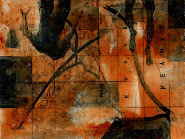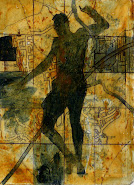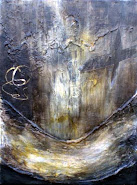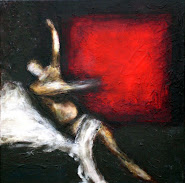I started to make some mental notes on the picture. My plan was to work through them in written form and then construct some kind of structured response to the painting. I think this would be a bit artificial; though. The nature of an initial and honest response is more suited to an unstructed, stream of consciousness style of writting. So...firstl;y apologies for the waffle that is too follow. Hopefully, however, it will provide the most transparent form of analysis. The function of the blog is, after all, to help us develop and evolve from criticism and sharing of ideas; not a place to show of our abilities to construct eloquent passages of writting. So here goes...
The first thing I noticed, obvioulsy, was the central characters. I then seemed to go through a process of deconstructing the iconography. As with all your paintings, and most contemporary figurative work, I was aware I was not in the search of specific characters names. This was not about attributing exact stories, the narrative or allegory is obvioulsy more detached than that.
Straight away this makes me aware of a problem in viewing contemporary work. (not a qualatative problem, not a case of better or worse, but a dilemma) In 'traditional' figurative painting we know we are often after a search for narrative or allegory. When the scene seems to be natural, as if it could be taken from real life in terms of construction, as if things fit together, then we tend to read narrative. A story unfolds. When there are purposefull unrealalities, juxtposiitons, impossible interrelations we realise narrative cant be read so easily. What we often see if the painter attempting to convey something less tangible, less visable. This is when we tend to realise they are communicating allegory to us. The visualisation of an intellectual system of thought. By its nature more abstract and so prone to less clear modes of viewing.
Fast forward to the present and are, narration, figuration, image making etc has been fragmented, destroyed, taken to the brink, brought back, reinvented, killed and reborn a million times. The result is a visual landscape and system of vision/sight which is far less coherent, whose boundaries make far less sense. Narration and figuration otday is like a collage of broken parts attempting to coexist in union. It is like Frankensteins Monster. It has similarities to the prototype but cant exist in the same cultural society. (tenuous analogy at best, I know, but its what came to mind so lets stick to it and avoid any pretence to find something more sophisiticated)
So, where does that leave me with your cahracters. The fact I cant locate them in an exact system should not mean I necessarily feel obliged to search for allegory over narrative. Even more so than in historical paintings we seem to pride the intellect of allegory and philosophy over the raw emotions of narration and drama. Yet something about the faceted nature of yours, and contemporary painting in general, tells me that I should not be searching for such clear definition. I go back to Titian poesie. I wonder if in fact modern painting is more like poetry, capable of incompassing all levels of human consciousness, the base levels (eg eroticism) the mean level (narration and drama) and the 'higher levels' (philosophy and spirituality). Whilst I am not saying all of these appear in your work at every stage, I do belivee we should be serching for a mode of viewing and making which realises all these can coexist. That we can fluctuate seemlessly between the various poles and the shadows inbetween. For some reason I feel inclind to call this a meta narrative, but I tihnk that is wrong. Who knows.
I look to your woman and I see a cross between something motherly and regal, monarhcial and domestic. She appears powerful and timeless yet also an individual, warm and comforting. I tihnk this is articulated by her pose more than anything. Her face and characterisation in the features also assist the reading.
The old guy. Well, as suggested I firstly see a wise old man. Its a crude and horrible label but its clearly what he is. He appears sad yet serious. He has a sculptural solidity of form that gives him power.
I soon reaslie that each cahracter can only be defined or make sense by the relationship between the two. Excusing the additional canvas, for the moment, they sit in seperate halves of the central painting and dominated their space. As scuh it is impossible for a conversation not to open up between the two. I see them in oppositon. She looks out at us, she engages, she seems to be one of us, albeit a woman of power and importance. His actions are totally detached from us. He is isolatd, he is locked in the act of playing his instrument.
this dynamic makes me think that she is one of us. She seems to be top of the social hierachy, but from our world all the same. He, however, seems to be from a different realm. A god perhaps, certainly not a mortal. he is too importal, two idealised, two artifical in appearance.
The notion seems to be supported by the spatial plays of the female form. Only her top half seems to exist, as if she has been cut out and paste into this scene. She only just enters the stage, is only just granted a position in the action. yet the position seems less permanent, it appears more tenuous in its attachement, it appears not to be where she belongs. This reinforcfes my idea that she has been transported from our realm, one of us, to this other state. I dont see this as some kind of dream like thing at all. its more subtle than that.
He however, seems to be part of his very surrounding. The relation between him and the floor seems to suggest they are of the same source.
I snap out of it for a whil. I then think about sptial construction. The spliting of the picture plane into three vertical areas, all roughly even, provides the stage setting. It is quiet Davidian in its use of architectural backdrops as compositional devices to stage your narrative. He sits infront of two solid, classcial archways, she is in front of a less clear, a more ambiguous space. This supports some of the above ideas.
She seems silent, lost in though and awaiting our response. She and we become one; perhaps. Maybe im moving towards spice girls lyrics now, Im not sure that is useful. Oh well.
The old boy is, obvioulsy, playing na instrument. IN place of strings there appears to be a vacuum of sorts. I cant quite work it out, but it is intriquing me. It makes me think this is not a literal medoldy. This is not about actual music and its effect. Music seems to be a metaphor here. As if his playing is the planting of a tragic seed. As if he is a protagonist and the instrument is is seed, or the devise which creates and spreads the seeds. REgardless I have the image of some melancholic rhythm and medlody. This makes me think that he is slightly similar to the crow and putti in my work, but a far more complex and sophisiticated incarnation of the crow.
Yet I dont belivee his every action will have a direct conseuqence on the woman. It seems more distant than tha\t. A more kind of lyrical, detached protagonist. I bit like what I am currently trying to do with the drummer boy in a new painting. At this stage I feel I have few answers.
It brings me to a desire to ask new questions.To consider the use of depth, the style and the other iconographi features. The dog like creature is a great addition. I like the vagueness of the type of animal and he is very convinsingly tugging at that shadow. That is brilliant. I also like the way you have come across the addition. It is something oyu have arrived at through need and function not through a desire for originality. It provides an interesting extension. Its inclusion makes us more imagine the space above it as missing than the canvas as added... if that makes sense. It now appears to be a square with a space cut out rather than a vertical retangle with a shape added.
The spatial play is interstesting. There is a flatness created and a frtonality byt the raising of the floor to a more vertical angle. It is very late Cezanne and early Cubism (as influenced by Cezanne)It teases us. Gives the perspectival suggestion of space behind and beyond but then doesnt allow us to go there. It bring us back or keeps our attention on the main plot. It is an interesting little take on two foldness. I like it. As if to stick a further two fingers up at our delight to go beyond the surface you give us a series of windows. Each one teases us to look through and beyond but then is dark or solid. A wall which restricts and blocks entry rather than letting us in. The sign contradicts itself. It is a continuation of what artists like Manet, the Cubists and Tapies (to name three) do.
A have just realised that the additional canvas is brilliant. In adding it it creates, as previously said, a sense of a void above. The coordinates of this void are the exact same as those the other side of the old man in which the woman sits. Thus a play is built up between them. Abscence and prescence, etc etc. It makes her position ieven more tenuous, gives even more a sense that she does not belong. The old boy, however, clearly does. Colouristically he is part of his surroudns. He sits in an upside down T shaped space. The blues of the floor and his robe corrolate and above him that other dark blue seems to provide a counterpoint.
In terms of style, I am finding it hard to say much at all as I am not looking at it in the flesh. I tihnk your use of colour is improving all the time. The orange of the instrument agasint the blue of his robe is excellent. I still think you could push your tonal range further and I still think you could be even more sparing in the use of intense colour. Then I tihnk things will have a new level of theatre and the areas of more saturated colour will truly sing.
Some of the areas of painting look like your best yet. The fabrics are excellent. For some reason I am not convinced, totally, buy the old boys face and hair. But I feel I need to see it in person to make a fair comment. The drawing of it seems exceleltn but the paint itself seems to bother me. No, no... I am not articulating this well. Forget this point untill I see the work. It is all just a small element, the whole... which is far more important, is really working.
Christ... dont feel I have really got anywhere or said anything.I also need some lunch so must dash. Hope a sentence or two amoungst the crap is useful here. If it isnt then apologies. I think this work is very existing. The potential of what is to follow is excellent. i think this makrs your biggest step forward yet, in one work. As a compelted piece, however, I prefer 'Mary and Ethel.' For me that just works. It has an immediacy and the depth that keeps grabbingme, keeps getting me to go back. I tihnk this has more sophisitcation as a whole but 'Mary and Ethel...' feels so right.
Our Artwork
Subscribe to:
Post Comments (Atom)




































No comments:
Post a Comment